Asparagus
West Coast asparagus markets continue to rise as Mexico’s Northern Baja region is past peak production. Markon First Crop (MFC) Asparagus is available; however, larger sizes (extra-large and jumbo) are extremely limited on the West Coast.
Mexico
- Large sizes remain tight; Central Mexico’s season has ended, concentrating all demand on Northern Baja
- Storm-damaged fields along with warm, wet conditions last month in Northern Baja have created conditions for faster spear growth
- Growers are now forced to cut ahead of schedules, due to the rapid growth (length), not allowing spears time to increase diameter
- Prices for all sizes will remain high through November as volume declines
Peru
- Peruvian asparagus (mainly imported through Florida) is being flown to the West Coast to supplement large sizes
- Volume is strong, as Peruvian growers are in peak production (September through December)
- Expect overall market demand to increase as Thanksgiving nears
Bell Peppers
California red bell peppers are extremely limited due to cold, rainy weather in the coastal growing regions. Green pepper volume is slowly increasing in the California desert area.
Red Bells
- MFC and Markon Essentials (ESS) Red Bell Peppers are extremely limited; packer label will be substituted as necessary
- The California coastal region will see rain and low evening temperatures (34 to 38 degrees), drastically reducing supplies
- The Coachella season is expected to start in the third week of November
- Production will begin in Western Mexico (crossing into Nogales, Arizona) by mid- to late December
- Canadian greenhouse production will wind down over the next 10 days due to limited sunlight
- The East Coast does not produce a significant amount of colored bell peppers
- Expect prices to climb this week
Green Bells
- MFC and ESS Green Bell Peppers are available
- Volume is increasing in the California desert region
- All suppliers are harvesting this week
- Quality is excellent; size is dominated by jumbo and extra-large peppers
- Georgia and North Florida production has increased due to warmer weather
- Quality is good
- East Coast stocks are expected to decrease by mid-November due to previous hurricane damage
- Central Mexico is shipping consistent supplies (crossing through South Texas)
- The Nogales season will start in a limited manner over the next two weeks
- Expect markets to remain steady this week
Broccoli and Cauliflower
Broccoli
- Supplies from both the Salinas and Santa Maria Valleys are diminishing as the season winds down
- Widespread pin rot continues to affect the appearance and shelf-life of crowns
- Cooler weather, especially low nighttime temperatures, as well as rain in the forecast for this week will slow head maturation and could increase the occurrence of mildew in finished packs
- Expect elevated markets until mid-November
Cauliflower
- Cauliflower markets are escalating
- Supplies are extremely limited in both the Salinas and Santa Maria Valleys
- Quality is poor throughout the industry
- In addition to pin rot, early breakdown, off color, and brown spotting, low temperatures that are forecast for the end of this week will slow growth and reduce yields at the field level
- Suppliers are cutting ahead of scheduled acreage to avoid quality defects
- 12-count packs will be virtually non-existent
- 16-count cases will dominate availability as growers are forced to harvest immature fields
Arizona and California Desert Growing Regions
- Production is scheduled to begin by mid- to late November
- The Salinas Valley season will end by the first week of December
California Strawberries
Rain is expected in all California growing regions starting Sunday, November 6 through Wednesday, November 9. Expect extremely tight supplies and elevated markets through next week.
Salinas/Watsonville
- Forecasts call for rain starting Sunday, November 6, bringing an end to the season
- Volume is extremely limited; quality is average at best
- Production will be completed in the next 7-10 days
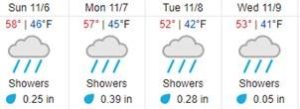
Santa Maria
- MFC Strawberries are available
- The forecast calls for rain starting Sunday, November 6
- Supplies are extremely limited and are predicted to not meet demand through most of November
- Quality is average; strawberries will see upwards of 25% bruising and 4% decay upon arrival
- Maintaining the cold chain will be vital for shelf-life; Markon recommends ordering for quick turns
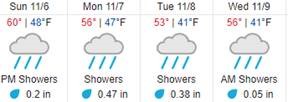
Oxnard
- MFC Strawberries are available
- The forecast calls for rain starting Monday, November 7
- Supplies are extremely limited and are predicted to not meet demand through most of November
- Quality is average; strawberries will see upwards of 25% bruising and 4% decay upon arrival
- Maintaining the cold chain will be vital for shelf-life; Markon recommends ordering for quick turns
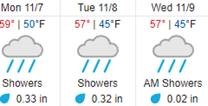
Cantaloupe
MFC Cantaloupes are limited; packer label is being substituted as needed. Supplies are tightening as the Arizona/California desert season winds down.
- Drought and water restrictions on the Colorado River have led to fewer acres of melons planted this desert season
- Size is dominated by 9-count fruit
- 12-count melons are snug
- 15-count and smaller fruit remains extremely limited; demand exceeds supply
- Expect elevated markets through the transition from domestic stocks to import orders
- The offshore cantaloupe season will begin in November
- The first East Coast vessel arrival is expected into Florida the week of November 7
- The first West Coast arrival is forecast into California the week of November 21
Iceberg
Iceberg lettuce supplies remain extremely tight. Some California suppliers have exhausted their Salinas Valley fields and have begun the desert season early, while others are harvesting in Oxnard or Huron to bridge the gap. Case weights are low in all growing regions.
Salinas, California
- Disease and plant virus issues persist in the few remaining acres of Salinas lettuce
- Case weights for 24-count liner lettuce range from 33 to 40 pounds
Huron, California
- Supplies are limited
- Very few suppliers are harvesting in Huron this fall due to water shortages
- There is little or no soil disease in iceberg fields
- Quality is very good with no seeder or soil disease issues present
- Head size is small
- Case weights for 24-count liner lettuce range from 32 to 35 pounds
Oxnard, California
- Supplies are tight, but fields are yielding much more than Salinas
- There is little or no soil disease in iceberg fields
- Seeder/long core and bottom rot have been the main challenges
- Case weights for 24-count liner lettuce range from 34 to 40 pounds
Yuma, Arizona
- A small number of suppliers started harvesting this week, slightly ahead of schedule
- There are no soil disease or plant virus challenges in the desert; stands look very good
- Quality is good apart from some seeder/long core
- Case weights for 24-count liner lettuce range from 27 to 35 pounds and will gradually increase
Salinas Valley Weather
California’s Salinas Valley started receiving rainfall shortly after noon today; .30”-.50” of rain is expected through tomorrow morning, Wednesday, November 2. Markon suppliers have packed orders ahead to minimize any delays and will work on keeping boxes as clean and dry as possible.
Following the rain, freezing morning temperatures are anticipated for the tail end of the week, with more rainfall possible on Sunday, November 6 through Monday, November 7.
Green Leaf, Iceberg, and Romaine
Stocks remain extremely limited; record-high market levels continue to rise. Rain is forecast for tomorrow, Tuesday, November 1, in the Salinas Valley and will further limit availability. Suppliers of all three commodities have not been able to fulfill 100% of their weekly contract commitments or regular open-market business over the past five weeks.
- Production in Salinas and Santa Maria, California will continue through early to mid-November; some growers in Salinas have finished for the season
- Approximately 0.25” of rainfall is forecast for tomorrow in the Salinas Valley; Santa Maria is expected to receive less than 0.05”
- Markon is working with suppliers to pack ahead as much as possible ahead of the rain event
- Harvesting of all three commodities continues in Huron and Oxnard, California; 0.05” of rain fall is expected in Huron tomorrow; rain is not forecast in Oxnard
- The majority of suppliers will harvest their first fields in the desert regions of Yuma, Arizona and Imperial Valley, California the week of November 7; some suppliers have started harvesting iceberg and romaine in Yuma, Arizona
- Quality and weights will vary depending on growing region, field location, and timing of harvest, as growers stretch their production schedule for harvestable product
- Expect lightweight commodity boxes and quality challenges in green leaf, iceberg, and romaine through mid-November, until transition to the Arizona/California desert is completed
Northwest Onions
MFC Onions are being shipped out of storage from Idaho, Oregon, Utah, and Washington. The Northwest season will run through April.
- Growers planted approximately 7% to 10% fewer acres this season due to higher input costs such as fuel, labor, fertilizers, and packaging
- The Northwest experienced unfavorable cold and rainy weather this past spring during the planting phase, forcing many growers to plant later than normal
- The weather was also hotter than normal during the growing season
- Overall crop size is smaller again this season due to the weather swings
- Medium and jumbo onions dominate availability; limited amounts of colossal and super colossal are available; there will continue to be a significant price gap in the medium and large size packs ($6.00 to $9.00 between medium and jumbo sizes)
- Onion quality is excellent; supplies possess solid, globe-like shape, and firm texture
- Yellow onions have golden, cured skins
- Red onion skins have set nicely with occasional papery layers
- Despite acreage being down, softer overall demand has kept prices stable
- Expect steady markets through the holidays followed by an increase after the New Year as suppliers assess remaining volume
- Below is a recent USDA Shipments report on the dry onion category, concurring with the weaker overall demand (shipments are down approximately 14% from 2021)
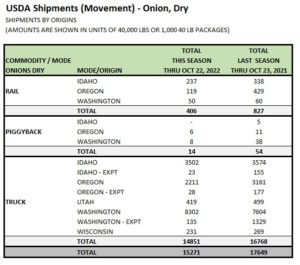
Potatoes – Norkotah and Burbank
Fresh-run, new crop MFC Norkotah Potatoes are currently be shipped out of Idaho and Washington. Limited supplies of MFC Idaho Burbank Potatoes will hit the market this week.
Norkotahs
- Norkotahs will be the primary variety shipped until spring
- More Norkotahs will be harvested than in past seasons
- Over the past several years, Idaho Norkotah performance has improved and is now comparable to Burbank variety, exhibiting higher solid content and less moisture
- Many growers favor Norkotahs as they have a shorter growing cycle and exhibit higher yields, stronger quality, and better size profile than the Burbank variety
Burbanks
- Expect limited availability of Burbanks through February
- Burbanks are more suited for late-season storage; however, growers continue to plant fewer each year
- The North American Potato Market News predicts another decline in Burbank market share
- In 2021/2022, Idaho suppliers packed close to 60% Norkotahs, compared to over 40% Burbanks
- With an already expected decline in overall potato volume from last season, the percentage gap will widen in favor of Norkotahs
- Below is data compiled by the Idaho and Eastern Oregon Potato Committee showing Burbank and Norkotah shipment comparisons since 1992
- Expect Burbanks to be $1.00-$3.00 higher than Norkotahs, depending on pack size
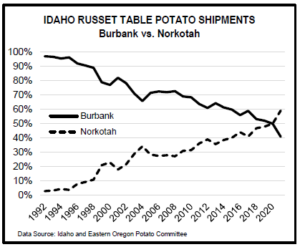
Ready-Set-Serve (RSS) Processor’s Seasonal Transition
Please click here to view a video about how Markon’s RSS salad processors move their seasonal production from Salinas, California, to Yuma, Arizona.
- Markon’s suppliers of value-added salad items follow the seasonal lettuce transition in the fall and spring
- Relocating their processing capabilities allows them to pack the freshest product possible and achieve optimum quality and shelf-life
- The process of disassembling, transporting, and reassembling equipment for full-scale production in less than three days is a huge undertaking
- By the week of November 21, all of Markon’s Salinas-based value-added suppliers will be shipping from Yuma, Arizona
Please contact your Markon customer service representative for more information.
©2022 Markon Cooperative, Inc. All rights reserved.